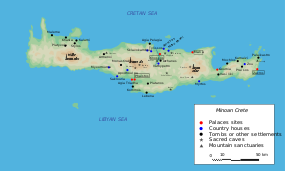Zakros
 Map of Minoan Crete | |
| Location | Lasithi, Crete, Greece |
|---|---|
| Coordinates | 35°05′53″N 26°15′41″E / 35.09806°N 26.26139°E |
| Type | Minoan town and "palace" |
| History | |
| Cultures | Minoan |
| Site notes | |
| Excavation dates | 1901, 1961- |
| Archaeologists | D.G. Hogarth, N. Platon |
| Public access | Yes |
Zakros (Greek: Ζάκρος; Linear B: 𐀼𐀒𐀫 zakoro;[1] also Zakro or Kato Zakro) is a Minoan archaeological site on the eastern coast of Crete in Lasithi, Greece. It is regarded as one of the five Minoan palaces, and its protected harbor and strategic location made it an important commercial hub for trade to the east.


The town was dominated by the Palace of Zakro, originally built around 1900 BC, rebuilt around 1600 BC, and destroyed around 1450 BC along with the other major centers of Minoan civilization. Extensive ruins of the palace remain, and are a popular tourist destination.
Zakros is sometimes divided into Epano Zakros (Upper Zakros), the portion higher up on the hillside, and Kato Zakros (Lower Zakros), the part near the sea. A Minoan villa was discovered on the road from Epano Zakos near the gorge. It is dated to the Minoan LM IA period, before the construction of the palace.[2] A ravine (usually referred to as a gorge in archaeological publications) known as the "Ravine of the Dead" runs through both the upper and lower parts of the ancient site, named after the numerous burials that have been found in the caves along its walls.
It has been proposed that the ancient name of the site was Ditka.[3]
Archaeology[edit]
The site was first recorded by Thomas Abel Brimage Spratt in 1851.[4]
Zakro was excavated by D.G. Hogarth of the British School of Archaeology at Athens in 1901 working primarily in the central area.[5][6][7] A single Linear A inscribed roundel (3.00 by 2.80 by 1.20 centimeters) was found, in the same deposit with a Linear A tablet and a number of clay sealings. Three of the sealings were inscribed with Cretan hieroglyphs. The deposit was in a destruction layer dated between layers LM IA and LM IB.[8][9] Human remains were found in caves at the gorge.[10]
In 1961, Nikolaos Platon resumed the excavation and discovered the Palace of Zakro.[11][12] This site has yielded several clay tablets with Linear A inscriptions.[13][14]
A number of seals, mainly of steatite, and clay sealings have been found at Zakros.[15][16][17]
References[edit]
- ^ Richard Vallance Janke, The Rôle of Supersyllabograms in Mycenaean Linear B, Presentation at the Pultusk Academy of Humanities, Poland, June 30 - July 2, 2015, p. 4.
- ^ Mantzourani, Eleni, and Giorgos Vavouranakis, "Achladia and Epano Zakros: A Re-examination of the Architecture and Topography of Two Possible Minoan Villas in East Crete", Opuscula Atheniensia 30, pp. 99-125, 2005
- ^ [1]Huxley, George, "The Ancient Name of Zakro", Greek, Roman, and Byzantine Studies 8.2, pp. 85-87, 1967
- ^ Thomas Abel Brimage Spratt (1865). Travels and Researches in Crete. J. van Voorst. OCLC 1000662504. Volume 1
- ^ D.G. Hogarth, "Excavations at Zakro, Crete", Annual of the British School at Athens 7, pp. 121-49, 1901
- ^ Dawkins, R. M., "Pottery from Zakro", The Journal of Hellenic Studies 23, pp. 248-260, 1903
- ^ [2]Hogarth, David George, "Bronze-age vases from Zakro", The Journal of Hellenic Studies 22, pp. 333-338, 1902
- ^ D. G. Hogarth, "The Zakro Sealings", JHS 22, pp. 76-93, 1902
- ^ Perna, Massimo, "The Roundel in Linear A from Zakro Wc 2 (HM 84)", Kadmos 33.1, pp. 29-37, 1994
- ^ W. Boyd Dawkins, "Skulls from cave burials at Zakro", Annual of the British School at Athens 7, pp. 150-55, 1901
- ^ Platon, N, "Ανασκαφή Ζάκρου", Prakt, pp. 216-224, 1961
- ^ Platon, N, "Ανασκαφή Ζάκρου", Prakt, pp. 142-168, 1962
- ^ Brice, William C., "The Zakro Tablets 16, 17 and 18", Kadmos 21.1, pp. 9-14, 1982
- ^ Hooker, James T., "Remarks on the Linear A Inscriptions from Zakro", Kadmos 16.1, pp. 13-15, 1977
- ^ Hogarth, D. G., "Note on two Zakro sealings", Annual of the British School at Athens 17, pp. 264-265, 1911
- ^ [3]Weingarten, Judith, "Aspects of tradition and innovation in the work of the Zakro Master", Bulletin de Correspondance Hellénique 11.1, pp. 167-180, 1985
- ^ Weingarten, Judith, "Two inscribed sealings from Zakro", Kadmos 22.2, pp. 107-108, 1983
See also[edit]
Further reading[edit]
- Bosanquet, R. C., "Excavations at Palaikastro. II: § 3.—The Chronology of Palaikastro and Zakro", Annual of the British School at Athens 9, pp. 281-287, 1903
- Chrysoulaki, S., and L. Platon, "Relations between the town and palace of Zakros", in R. Hagg, and N. Marinatos (eds.), The Function of the Minoan Palaces, Proceedings of the Fourth International Symposium at the Swedish Institute in Athens, 10 –16 June 1984 (Acta Instituti Atheniensis Regni Sueciae, Series 4º: ΧΧΧV), Stockholm, 77– 84, 1987
- [4]Nikolaos Platon, "Zakros: The Discovery of a Lost Palace of Ancient Crete", Scribner, 1971 ISBN 978-0684311036
- Platon, Lefteris, "Studying the Character of the Minoan 'Household' within the Limits of the Neopalatial Settlement of Zakros", Hesperia Supplements 44, pp. 151-161, 2011
- Stieglitz, Robert R., "The Minoan Pithos Inscription from Zakro", Kadmos 22.1, pp. 5-7, 1983
- Thompson, James G., "Clues to the location of bull jumping at Zakro", Journal of Sport History 19.2, pp. 163-168, 1992
- Weingarten, Judith, "The use of the Zakro sealings", Kadmos 22.1, pp. 8-13, 1983
